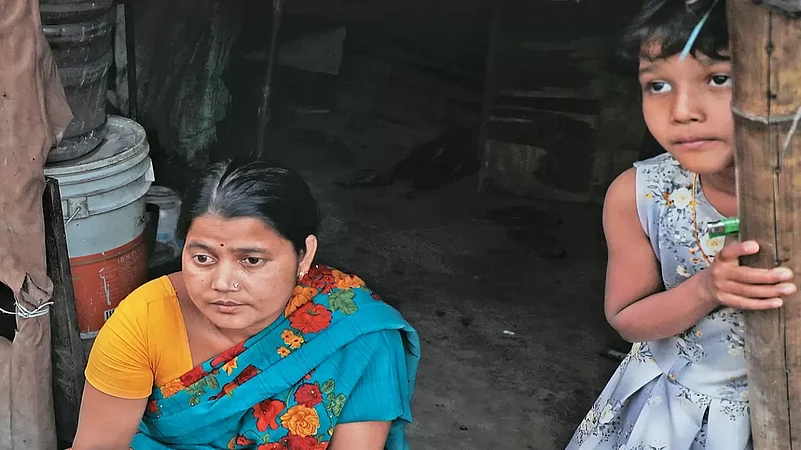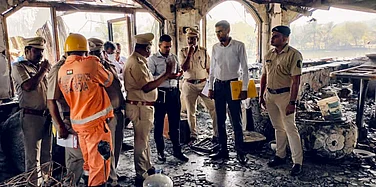It was a hard choice to make—join the lakhs of desperate migrant workers on their perilous journey back home in March 2020 or stay put and endure the complete shutdown of life in the big city without any source of income. Banani and her family chose the former. It was three years ago around this time in March that the migrant domestic worker from West Bengal stared at this predicament filled with uncertainty and anguish. In the Sangam Vihar slum of South Delhi, where Banani lives in a tiny ramshackle hut surrounded by piles of stinking garbage, her family was trying to cut their losses.
“We thought we could somehow survive in the city. If we moved towards our native place, we would be kept under quarantine in a room in some school for several days. Would they provide us food? It would have been harder in the village with absolutely no work to do,” says Banani.
One among the estimated five lakh domestic workers in the national capital region, Banani lives with her husband Tapan, a rag-picker, and their six children including five daughters. They have two more older daughters who are married. With so many mouths to feed, the family faced an unprecedented crisis during the lockdown. The queues for the government-run ration distribution were so long that Banani gave up on most days. The husband-wife duo lost their jobs during the lockdown. It was only with a little help from NGOs and local gurudwaras and food packets distributed by the government that the family made it through the difficult period. “All our savings, Rs 50,000-60,000, were wiped out during the lockdown,” says Banani. “There was no food, water or ration. We would drink two glasses of water and sleep,” adds Tapan recalling those trying days of the pandemic.
For several months during the peak of the pandemic, Banani had had no work. Since domestic workers were among those sections who were allowed to enter other peoples’ households, they faced hostility from residential welfare associations and were stigmatised as carriers of the virus. Three years later, she is back cleaning, cooking and providing care in the homes of others. But things are not the same anymore. With rising inflation and irregular and inadequate wages, the couple’s struggle has become harder. “If I demand Rs 5,000-6,000, I am just paid Rs 2,000-2,500,” says Banani, whose young daughter was forced to drop out of the school she was attending before the lockdown.
Domestic workers in the national capital face peculiar problems. They are not recognised in the scheduled list of workers and thus not considered eligible for minimum wages unlike, say, construction workers. Their wage loss during the lockdown was not taken into consideration and they received no compensation from the government, says Shreya Ghosh, activist at the Migrant Workers Solidarity Network. “Even during the lockdown, domestic workers didn’t get any protection,” says Ghosh, adding that domestic workers were excluded from the emergency cash grants that were extended to registered groups of unorganised sector workers, especially construction workers.
Ghosh says that a large section of domestic workers has resumed work since the two lockdown phases but their situation has not really improved. As many people from middle-class households are working from home, demand for domestic help has fallen. Apart from issues of arbitrary wages, late payment and non-payment, domestic workers also often face allegations of theft and threats of sexual and financial exploitation. Sometimes this leads to violence. As in the case of a minor girl from Jharkhand who was allegedly tortured over five months by her employers in Gurgaon before being rescued.
The fate of other domestic workers is no less harsh. Saraswati, who hails from Aligarh, lives in a cramped rented room in Harkesh Nagar, Okhla, paying Rs 4,000 rent and with two children to feed. In 2020, when her father-in-law died, she returned to her husband’s native village two days before the lockdown. Now, back in the capital, Saraswati says she struggles to find decent employers and wages. There is no work back in Aligarh and she is now engaged in fitting jewellery stones in a home-based set-up for much lower wages. “If I demand a certain pay as a domestic help, the employers ask me to do the work at their wages or leave. I have no other choice but to continue this job even at low wages,” she says.
There is no reliable official data on migrant workers who work as domestic workers in the country. While states such as Tamil Nadu, Karnataka and Rajasthan have legislations for their welfare, there is no such central policy. In November 2021, Union Minister for Labour and Employment, Bhupender Yadav flagged off the first ever All India Survey on Domestic Workers being conducted by the Labour Bureau, Chandigarh. The survey, which will cover 6,190 villages, 1.50 lakh households and 6,576 Urban Frame Survey (UFS) blocks, aims to estimate the number and proportion of domestic workers at the national and state levels, percentage distribution of domestic workers with respect to live-in and live-out, formal and informal employment, their wages and other socio-economic characteristics. The survey would also collect information on their migration status, distance travelled, engagement before and after the COVID-19 pandemic and its effect on wages and jobs, living conditions and social security benefits received. However, since its results have still not been made public, workers will have to wait longer for any government intervention.
According to a report published by the NGO Women in Informal Employment: Globalizing and Organizing, following the first wave of COVID-19, the bulk of the estimated 5 lakh DWs in Delhi are part-time workers; most have multiple employers and work more than 40 hours per week. They spend the equivalent of three-quarters of a week’s wage on healthcare visits and migrant workers often encounter problems in applying for benefits because the necessary documentation is at their home villages for safekeeping and is inaccessible to them.
According to Ghosh, after the ease of the lockdowns, more women are looking for work and the ‘surplus labour’ in the sector has increased. “Everyone wants to do as much work as possible because of a rise in the cost of living. Some are working 15 hours a day to reach the wage level that they were getting before the lockdowns,” she said. Experts say that for most migrant women, domestic work becomes a viable option as it requires low levels of skill and has an easy entry. Many women start working upon following their husbands to the cities.
The biggest struggle of domestic workers, especially migrants, is their identity, says Neeresh Bansal, an activist with SEWA India, an NGO that works with domestic workers across the country. “Only when they get a legal identity will they get minimum wage—as a worker. We want a welfare board to be made by the government so that domestic workers also receive benefits of provident fund, pension and other schemes, apart from medical facilities,” says Bansal.
In Delhi’s Shakur basti, where slum dwellers live close to a railway track, residents fight power supply issues and live in unhygienic conditions in the midst of open drains and garbage. The public toilet is in a pitiable state. Among the residents is Shama Khatoon, a migrant from Bihar. A domestic worker, Khatoon says her earnings have fallen sharply since the COVID-19 period. “Earlier, I used to get Rs 2,000 per household, now it’s not more than Rs 1,500. They simply say, ‘We do not have money. If you want it, take it. Or go,’” she says.
In many cases, domestic workers like Dipali Manjhi are also exploited financially. The ‘woman of the house’ where she worked had just delivered an infant before the lockdown, thus increasing Manjhi’s workload. But instead of compensating her for the additional work, she was deprived of her basic pay. The household owed her Rs 7,500 per month but did not pay her till the 20th of each month, thereby trapping her in the job. She managed to get her pending dues only through external pressure applied by members of an NGO.
On February 13, Minister of State for Labour and Employment, Rameswar Teli, informed the Rajya Sabha that the survey on domestic workers was at its final stages. Can the survey pave the way for a better future for migrant domestic workers? More importantly, will the survey ever see light of day with its results made available to the public? The answers hang in the air.
(This appeared in the print as "Homemaker’s Bane")


























